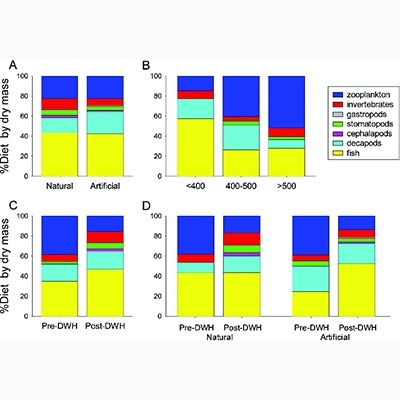
Changes in Red Snapper Diet and Trophic Ecology Following the Deepwater Horizon Oil Spill
Red Snapper Lutjanus campechanus were sampled at 33 natural and 27 artificial reef sites in the northern Gulf of Mexico prior to (2009–2010) and after (2010–2011) to examine potential diet and trophic shifts following the Deepwater Horizon (DWH) oil spill. We dissected 708 stomachs for gut content analysis and processed 65 muscle tissue samples for stable isotope ratio-mass spectrometry analysis of δ13C, δ15N, and δ34S. Forty-eight percent of stomachs contained identifiable prey, which we grouped into seven categories: fish, decapods, cephalopods, stomatopods, gastropods, zooplankton, and other invertebrates. Based on these categories, Red Snapper diet was significantly different following the DWH oil spill, and was differentially affected by fish size. The interaction between habitat (natural versus artificial reefs) and DWH oil spill effects was also significant. Significant differences in diet among Red Snapper size-classes were due to low trophic position prey, such as pelagic zooplankton, being more abundant in the diet of larger (>500 mm) Red Snapper, while decapods and fish constituted a higher proportion of the diet of smaller individuals. Red Snapper consumed higher amounts of decapods at artificial (21.9% by mass) versus natural (14.8%) reef sites, but the habitat effect on diet was not significant. The habitat × DWH timing interaction was driven by a decrease in zooplankton consumed at both habitat types, increased benthic prey at natural reefs, and increased fish consumption at artificial reefs in post-DWH oil spill samples. Stable isotope data indicated a postspill increase in Red Snapper trophic position (15N enrichment) and an increase in benthic versus pelagic prey (34S depletion), both consistent with observed dietary shifts. Overall, results indicate shifts in Red Snapper diet and trophic position occurred following the DWH oil spill, thus the relative abundance of prey resources likely changed.
The full article is available at the link below:
http://www.tandfonline.com/doi/full/10.1080/19425120.2015.1020402
Tarnecki, J. H., & Patterson III, W. F. (2015). Changes in Red Snapper Diet and Trophic Ecology Following the Deepwater Horizon Oil Spill. Marine and Coastal Fisheries, 7(1), 135–147.


